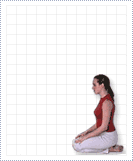The Half Moon Pose (Ardha-chandra-asana) Instruction:
Sirsha-asana - The Head-stand

1
Sit in a kneeling position with the buttocks resting on the heels of the feet.
2
Lean forward and place the forearms on the floor in front while keeping the elbows about shoulder distance apart. Interlock the fingers of both hands.
3
Place the top of the head flat on the floor with the back of the head pressed against the inside of the interlocked fingers.
4
Placing the tips of the toes firmly on the floor while lifting the heels, raise the knees off the floor.
5
Hold for the duration of the held inhaled breath. When you can't hold the breath comfortable any longer, slowly exhale and return the back to the floor, slide the legs out straight returning to the shava-asana.
Comments:
Sirsha-asana - The Head-standThe headstand or sirsha-asana is perhaps the most well-known Yoga posture. Its benefits are many and is fully deserving of all its notoriety. Its physical and mental benefits derive both from emphasis on balance and the body's inverted position.
Before attempting the sirsha-asana beginners to Yoga should wait until they have mastered some of the more basic postures (such as the sarvanga-asana, dhanura-asana, ugra-asana, etc.). If you are attempting the headstand for the first time and you are alone we recommend you position yourself facing a wall with your knees about three feet from the wall. If you should lose your balance after lifting your legs you can use the wall for support to return gently from the posture.
The greatest physical benefits of the sirsha-asana are to the neck, spine and brain. Regular practice of this posture adds suppleness to the spine and increases the flow of blood to the brain. It enhances poise and balance and relieves stress and tension in the lower portions of the body.
The benefits of sirsha-asana are not only physical. The mental benefits are also plentiful. You will find that daily practice of the headstand enhances awareness, sharpens attention and improves the memory.
Durations/Repetitions:
Hold the sirsha-asana for 15-30 seconds when you first attempt it and increase the duration gradually over a period of a few weeks. As you skill increases you should hold it for as long as you feel comfortable.
Cautions/Restrictions:
If you are new to Yoga we recommend that you find a qualified instructor to teach you this posture and monitor you performance. If you attempting this alone position yourself in front of a wall as mentioned above.
If you are suffering from high or low blood pressure you should not attempt this posture.
The sirsha-asana should not be performed by woman who are menstruating, as is the case with all inverted postures (where the legs are raise over the head).
Variations:
There are several variations to the sirsha-asana that you can try when you are comfortable with the standard variation. First try spreading your legs wide apart, carefully separating them very slowly, while maintaining your balance, until they are as far apart as is comfortable. Bring your legs together before returning from the posture. Next you can try placing the soles of your feet together while steadily holding the pose.
